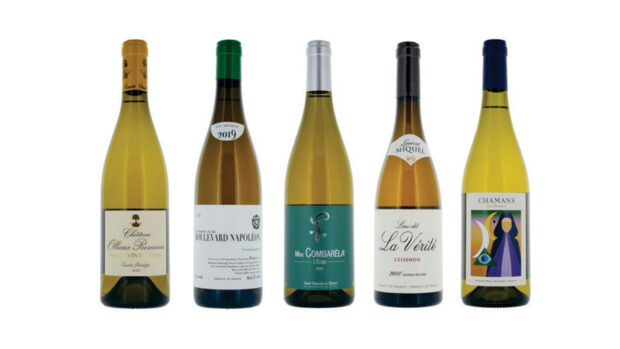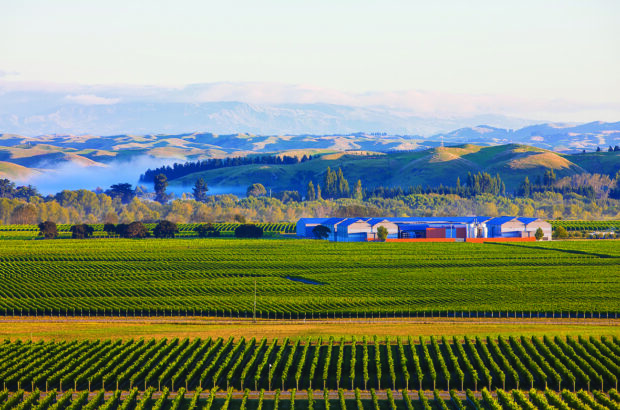Be among the first to see the results of our vintage Champagne panel tasting, just published in the Christmas issue of Decanter magazine and with scores and tasting notes currently available exclusively to Premium members on Decanter.com.
With consumers increasingly calling for local individuality and provenance, the market is moving in favour of these more exacting styles, says Michael Edwards.
Setting the scene
The Champagne heartland, 145km east of Paris, has treacherous weather, which brings icy winters, mercurial springs and the threat of destructive frost.
Yet climate change, particularly since 2005, has often ushered in warmer, earlier harvests and higher levels of sugar in the grapes, achieving about 10% natural alcohol in the first fermentations, ideal for fine sparkling wine.
Yet warming has also brought extremes, particularly in chaotic August rainfall, as in 2010, 2011 and 2017, when the prospect of a great, warm ‘continental’ vintage like 1996 was dashed by downpours for Pinots Noir and Meunier.
{"content":"PHA+UXVhbGl0eSBpcyB2YXJpYWJsZSBmcm9tIHllYXIgdG8geWVhciwgc28gYmxlbmRpbmcgd2luZXMgZnJvbSBkaWZmZXJlbnQgdmlsbGFnZXMsIGFuZCBib2xzdGVyaW5nIGFueSBzaG9ydGZhbGxzIGluIHRoZSBjdXJyZW50IGJhc2Ugd2luZSB3aXRoIHN0cm9uZ2VyIHJlc2VydmUgd2luZXMgZnJvbSBlYXJsaWVyIHllYXJzLCBpcyB0aGUga2V5IHRvIG1ha2luZyB0aGUgbm9uLXZpbnRhZ2UgY3V2w6llcyB0aGF0IGFjY291bnQgZm9yIHVwIHRvIDkwJSBvciBtb3JlIG9mIHNhbGVzIGZvciBtb3N0IGdyb3dlcnMgYW5kIGhvdXNlcy5WaW50YWdlIENoYW1wYWduZXMgYXJlIGlkZWFsbHkgbWFkZSBpbiBhbiBleGNlcHRpb25hbCBoYXJ2ZXN0IHdoZW4gdGhlIHdpbmUgaGFzIGEgc3BlY2lhbCBjaGFyYWN0ZXIgdGhhdCB0cmFuc2NlbmRzIHRoZSBOViBob3VzZSBzdHlsZS5UaGVyZSBpcyBhIHRyZW5kIHRvd2FyZHMgbWFraW5nIG1vcmUgdmludGFnZSBDaGFtcGFnbmUg4oCTIGVzcGVjaWFsbHkgaW4gdGhlIFVTLCBhIHZpbnRhZ2UgbGFiZWwgaGFzIG1vcmUgbWFya2V0aW5nIHB1bmNoLjwvcD4KPHA+PGRpdiBjbGFzcz0iYWQtY29udGFpbmVyIGFkLWNvbnRhaW5lci0tbW9iaWxlIj48ZGl2IGlkPSJwb3N0LWlubGluZS0yIiBjbGFzcz0iaXBjLWFkdmVydCI+PC9kaXY+PC9kaXY+PC9wPgo8cD5BIGNsYXNzaWMgdmludGFnZSBjdXbDqWUgZnJvbSB0aGUgZ3JlYXQgaG91c2VzIGlzIGxpa2VseSB0byBpbmNsdWRlIG1haW5seSBncmFuZCBjcnUgZ3JhcGVzIG9mIFBpbm90IE5vaXIgZnJvbSwgc2F5LCBWZXJ6ZW5heSAoc3RydWN0dXJlKSwgYcO\/IChncmFjZSkgYW5kIEJvdXp5IChyaWNobmVzcykgYW5kLCBmb3IgQ2hhcmRvbm5heSwgZnJvbSBBdml6ZSAoc3RyZW5ndGgpLCBDcmFtYW50IChkeW5hbWlzbSkgYW5kIExlIE1lc25pbCAobWluZXJhbCBsb25nZXZpdHkpIOKAkyBwbHVzIGEgZGFzaCBvZiBQaW5vdCBNZXVuaWVyLiBEb3NhZ2UgbGV2ZWxzIGFyZSBjb21pbmcgZG93biB0byBiZXR3ZWVuIDUtOCBncmFtcyBwZXIgbGl0cmUgb2Ygd2luZS48L3A+CjxoMj48c3Ryb25nPlNlbnNlIG9mIHBsYWNlPC9zdHJvbmc+PC9oMj4KPHA+QSB3ZWxjb21lIHBoZW5vbWVub24gaW4gcmVjZW50IHllYXJzIGhhcyBiZWVuIHRoZSByaXNlIG9mIGdyb3dlciBDaGFtcGFnbmVzLiBUaGVzZSBkb21haW5lcywgYSBiZXR0ZXIgd29yZCwgdGFrZSB0aGVpciBpbnNwaXJhdGlvbiBmcm9tIEJ1cmd1bmR5OiB0aGV5IHdhbnQgdG8gZXhwcmVzcyBhIHNlbnNlIG9mIHRoZWlyIGxvY2FsZSBpbiB0aGVpciBtb25vLWNydXMgYW5kIHNpbmdsZS12aW5leWFyZCBDaGFtcGFnbmVzLCBvZnRlbiB3aXRoIGV4dHJhIGJydXQgZG9zYWdlIG9yIGJhcmVseSBhbnkgc3VnYXIgYXQgYWxsLCBhcyBpbiBicnV0IG5hdHVyZS48L3A+CjxwPldoZXRoZXIgdGhpcyBkcml2ZSBmb3IgZXh0cmVtZSBkcnluZXNzLCBpbnRlbmRlZCB0byBzaG93IHRoZSB3aW5lcyBwdXJlIGFuZCB1bmFkdWx0ZXJhdGVkLCB3aWxsIGdhaW4gaW4gdHJhY3Rpb24gb3Igc3RhbGwgaXMgb3BlbiB0byBxdWVzdGlvbiwgYXMgc29tZSBsZWFkaW5nIHdpbmVtYWtlcnMgdGhpbmsgdGhhdCBhdCBsZWFzdCBtb2RlcmF0ZSBkb3NhZ2UgaXMgaW1wb3J0YW50IGZvciB0aGUgbG9uZyBsaWZlIG9mIENoYW1wYWduZS4gTmV2ZXJ0aGVsZXNzLCB0aGUgYmVzdCBvZiB0aGVzZSBkb21haW5lcyBoYXZlIGEganVzdGlmaWVkIGZvbGxvd2luZy48L3A+CjxkaXYgY2xhc3M9ImFkLWNvbnRhaW5lciBhZC1jb250YWluZXItLW1vYmlsZSI+PGRpdiBpZD0icG9zdC1pbmxpbmUtMyIgY2xhc3M9ImlwYy1hZHZlcnQiPjwvZGl2PjwvZGl2Pgo8cD5DZXJ0aWZpZWQgYmlvZHluYW1pYyBjdWx0aXZhdGlvbiByZXByZXNlbnRzIGxlc3MgdGhhbiAyJSBvZiBDaGFtcGFnbmUgcHJvZHVjdGlvbiwgYnV0IHRoaXMgY291bGQgcmlzZSBzbG93bHkgaWYgdGhlIHdhcm1pbmcgdHJlbmQgYWNjZWxlcmF0ZXMsIGluc3BpcmVkIGJ5IHRoZSBsYXJnZXN0IGV4cG9uZW50IG9mIGJpb2R5bmFtaWNzIExvdWlzIFJvZWRlcmVyLCB3aGljaCBzaWduaWZpY2FudGx5IGRvZXMgbm90IGhhdmUgY2VydGlmaWNhdGlvbiDigJMgYSB3aXNlIG1vdmUsIGVzcGVjaWFsbHkgaW4gY29tcGxpY2F0ZWQgaGFydmVzdHMuPC9wPgo8aDI+PHN0cm9uZz5DaGFtcGFnbmU6IHRoZSBmYWN0czwvc3Ryb25nPjwvaDI+CjxwPjxzdHJvbmc+PGRpdiBjbGFzcz0iYnJlYWtvdXQgcGFsZXR0ZS1hIHBhbmVsIHBhbmVsLWRlZmF1bHQiPjxkaXYgY2xhc3M9InBhbmVsLWJvZHkiPjxkaXYgY2xhc3M9J2JyZWFrb3V0LWNvbnRlbnQnPjxwPlRvdGFsIHN1cmZhY2UgYXJlYTwvc3Ryb25nPiAzNCwzMDZoYSwgb2Ygd2hpY2ggMzMsODA1aGEgaXMgaW4gcHJvZHVjdGlvbjwvcD4KPGRpdiBjbGFzcz0iYWQtY29udGFpbmVyIGFkLWNvbnRhaW5lci0tbW9iaWxlIj4KPGRpdiBpZD0icG9zdC1pbmxpbmUtNCIgY2xhc3M9ImlwYy1hZHZlcnQiPjwvZGl2Pgo8L2Rpdj4KPHA+PHN0cm9uZz5HcmFwZXM8L3N0cm9uZz4gUGlub3QgTm9pciAzOCUgKDEzLDgwMGhhLCBtb3JlIHRoYW4gaW4gYWxsIG9mIEPDtHRlIGTigJlPciwgQ2hhbG9ubmFpcyBhbmQgU2FuY2Vycm9pcyk7IFBpbm90IE1ldW5pZXIgMzIlOyBDaGFyZG9ubmF5IDI5LjklOyB0aGVyZSBhcmUgYWxzbyAxMDBoYSBvZiBQZXRpdCBNZXNsaWVyLCBQaW5vdCBCbGFuYyBhbmQgQXJiYW5lPC9wPgo8cD48c3Ryb25nPkNlcnRpZmljYXRpb25zPC9zdHJvbmc+IDxlbT5WaXRpY3VsdHVyZSBEdXJhYmxlIGVuIENoYW1wYWduZTwvZW0+IChzdXN0YWluYWJsZSB2aXRpY3VsdHVyZSk6IDEyJSA8ZW0+T3JnYW5pYzwvZW0+ICjigJhiaW\/igJkpIGFuZCBiaW9keW5hbWljOiAxLjUlIDxlbT5IYXV0ZSBWYWxldXIgRW52aXJvbm5lbWVudGFsZTwvZW0+IChoaWdoIGVudmlyb25tZW50YWwgVmFsdWUpIGFuZCBUZXJyYSBWaXRpczogMS41JTwvcD4KPC9kaXY+PGRpdiBjbGFzcz0nYnJlYWtvdXQtYnV0dG9ucyc+PGRpdiBjbGFzcz0ncm93Jz48L2Rpdj48L2Rpdj48L2Rpdj48L2Rpdj48L3A+CjxkaXYgY2xhc3M9ImFkLWNvbnRhaW5lciBhZC1jb250YWluZXItLW1vYmlsZSI+PGRpdiBpZD0icG9zdC1pbmxpbmUtNSIgY2xhc3M9ImlwYy1hZHZlcnQiPjwvZGl2PjwvZGl2Pgo8aDI+VGhlIHNjb3JlczwvaDI+CjxwPjxzdHJvbmc+Nzggd2luZXMgdGFzdGVkPC9zdHJvbmc+PC9wPgo8cD48c3Ryb25nPkVudHJ5IGNyaXRlcmlhOjwvc3Ryb25nPiBwcm9kdWNlcnMgYW5kIFVLIGFnZW50cyB3ZXJlIGludml0ZWQgdG8gc3VibWl0IHRoZWlyIGxhdGVzdCBVSy1hdmFpbGFibGUgcmVsZWFzZXMgb2Ygd2hpdGUsIGJydXQgYW5kIGV4dHJhIGJydXQgdmludGFnZSBDaGFtcGFnbmVzLCBub3QgaW5jbHVkaW5nIHByZXN0aWdlIGN1dsOpZXM8L3A+CjxwPjxzdHJvbmc+RXhjZXB0aW9uYWw8L3N0cm9uZz4gMDwvcD4KPHA+PHN0cm9uZz5PdXRzdGFuZGluZzwvc3Ryb25nPiAxPC9wPgo8cD48c3Ryb25nPkhpZ2hseSBSZWNvbW1lbmRlZDwvc3Ryb25nPiAyMTwvcD4KPHA+PHN0cm9uZz5SZWNvbW1lbmRlZDwvc3Ryb25nPiA0MDwvcD4KPHA+PHN0cm9uZz5Db21tZW5kZWQ8L3N0cm9uZz4gMTM8L3A+CjxwPjxzdHJvbmc+RmFpcjwvc3Ryb25nPiAzPC9wPgo8cD48c3Ryb25nPlBvb3I8L3N0cm9uZz4gMDwvcD4KPHA+PHN0cm9uZz5GYXVsdHk8L3N0cm9uZz4gMDwvcD4KPGgyPjxzdHJvbmc+VGhlIHJlc3VsdHM8L3N0cm9uZz48L2gyPgo8cD5XaXRoIGl0cyB5ZWFybHkgdmFyaWF0aW9ucyBhbmQgZm9vZC1tYXRjaGluZyBwb3RlbnRpYWwsIHZpbnRhZ2UgQ2hhbXBhZ25lIG9mZmVycyBmaXp6IGxvdmVycyByZWFsIGluc2lnaHQgaW50byB0aGUgcmVnaW9u4oCZcyB0cnVlIGNoYXJhY3RlciwgYXMgQ2hyaXN0ZWxsZSBHdWliZXJ0IHJlcG9ydHM8L3A+Cjxocj4KPHA+Q2hhbXBhZ25lIGlzIHRoZSB3b3JsZOKAmXMgbW9zdCBpY29uaWMgYmV2ZXJhZ2UsIG1vc3RseSBjb25zdW1lZCBkdXJpbmcgZmVzdGl2ZSBwZXJpb2RzLCBhdCBjZWxlYnJhdGlvbnMgb3Igc2ltcGx5IGFzIGFuIGluZHVsZ2VudCBkcmluay4gQnV0IGdpdmVuIHRoZSBjaG9pY2Ugb2Ygc3R5bGVzIChOViwgdmludGFnZSwgZGVsdXhlIGN1dsOpZSwgbGlicmFyeSwgcmVjZW50bHkgZGlzZ29yZ2VkJiM4MjMwOyksIGJ1eWluZyBDaGFtcGFnbmUgY2FuIGJlIGEgbWluZWZpZWxkLjwvcD4KPHA+RHVyaW5nIGEgd2lkZS1yYW5naW5nIGRpc2N1c3Npb24sIFNpbW9uIEZpZWxkIE1XIG5vdGVkIHRoYXQg4oCYdGhpcyB0YXN0aW5nIHByb3ZlcyB0aGVyZSBpcyB2aW50YWdlIHZhcmlhdGlvbiwgYnV0IHRvIHdoYXQgZXh0ZW50IGlzIHRoZSBjb25zdW1lciBnb2luZyB0byBidXkgaW50byB0aGF0IHdoZW4gdGhleSBjYW4gYnV5IGRlbHV4ZSBjdXbDqWVzIG9yIGNvbXBsZXggTlZzP+KAmTwvcD4KPHA+WGF2aWVyIFJvdXNzZXQgTVMgYXJndWVkOiDigJhXaGVuIGJ1eWluZyBhIHZpbnRhZ2UgQ2hhbXBhZ25lLCBJ4oCZbSBhZnRlciB0aGUgYnV0dGVyaW5lc3MsIHRoZSBjcmVhbWluZXNzLCB0aGUgZml6eiB0byBiZSBtb3JlIHNldHRsZWQgYW5kIGNvbXBsZXgsIGJ1dCB5b3UgY2FuIGdldCB0aGF0IHJlZ2FyZGxlc3Mgb2Ygd2hldGhlciBvciBub3QgaXTigJlzIHZpbnRhZ2Uu4oCZPC9wPgo8cD5GaWVsZCBhZGRlZDog4oCYVGhlIENoYW1wZW5vaXMgYXJlIHRyeWluZyB0byBzZWxsIG1vcmUgdmludGFnZSwgYnV0IGlmIHlvdSB3YW50IGNvbXBsZXhpdHkgeW91IGdvIGFjcm9zcyB2aW50YWdlLCBub3QganVzdCBjcm9zcy1yZWdpb25hbC4gT3IgaWYgeW91IGFyZSBnb2luZyB0byBkbyBhIHNpbmdsZSBzaXRlLCB0aGVuIHlvdSBoYXZlIHRvIGhhdmUgdGhlIGx1eHVyeSBvZiBibGVuZGluZyBtb3JlIHRoYW4gb25lIHZpbnRhZ2UsIG90aGVyd2lzZSB5b3UgYXJlIHRvbyByZXN0cmljdGVkLuKAmTwvcD4KPHA+Rm9yIE1pY2hhZWwgRWR3YXJkcywgYmxlbmRpbmcgaXMgZnVuZGFtZW50YWwgdG8gQ2hhbXBhZ25lOiDigJhUaGVyZSBpcyBhIHRyZW5kIHRvd2FyZCBzaW5nbGUgdmluZXlhcmRzIGFuZCB0aGVyZSBhcmUgc29tZSBvdXRzdGFuZGluZyB3aW5lcy4gQnV0IHRoZSBncmVhdCBwcm9kdWNlcnMgdXN1YWxseSBibGVuZCBmcm9tIGNvbnRpZ3VvdXMgdmluZXlhcmRzLCBhbmQgbm90IGp1c3QgZnJvbSBvbmUgdmludGFnZS7igJk8L3A+CjxwPldoZXRoZXIgb3Igbm90IHRoaXMgY2F0ZWdvcnkgb2ZmZXJzIGFueSBhZGRlZCB2YWx1ZSB0byBjb25zdW1lcnMgd2FzIGhvdGx5IGRlYmF0ZWQuIGFjY29yZGluZyB0byBGaWVsZCwgaWYgY29uc3VtZXJzIGFyZSBidXlpbmcgQ2hhbXBhZ25lIHRvIGltcHJlc3MsIHRoZXkgd2lsbCBnbyBmb3IgdGhlIGRlbHV4ZS48L3A+CjxwPlJvdXNzZXQgZmVsdCB0aGF0IHRoZSBDaGFtcGFnbmUgaG91c2VzIHNob3VsZCBvbmx5IG1ha2UgYSB2aW50YWdlIGluIHRoZSBiZXN0IHllYXJzOiDigJhUaGV5IHNob3VsZCBrZWVwIHRoZW0gYSBsaXR0bGUgbG9uZ2VyIGFuZCB0aGVuIHJlbGVhc2UgdGhlbSBhcyBhIOKAnG1pbmnigJ0gZGVsdXhlLuKAmTwvcD4KPHA+T24gcGFwZXIgdGhpcyBtYXkgc291bmQgbGlrZSBhIGdvb2QgcGxhbiwgYnV0IEZpZWxkIGhhZCByZXNlcnZhdGlvbnMuIOKAmFRoZSBkZWx1eGUgY3V2w6llcyBhcmUgYmVpbmcgcmVsZWFzZWQgZWFybGllciBhbmQgZWFybGllciwgYW5kIHRoZXkgY2Fu4oCZdCByZWxlYXNlIHRoZSB2aW50YWdlIGFmdGVyIHRoZSBkZWx1eGUu4oCZPC9wPgo8cD5FZHdhcmRzIGZlbHQgdGhhdCBjb2xsZWN0b3JzIHdpbGwgbm90IHdhbnQgdG8gcGF5IG92ZXIgdGhlIG9kZHMgYW5kIHdpbGwgbG9vayBhdCB2aW50YWdlIENoYW1wYWduZS4gQnV0IG92ZXJhbGwgb3VyIHBhbmVsIGNvbmNsdWRlZCB0aGF0IHRoZXJlIGlzIGEgdGVuZGVuY3kgZm9yIHRoZSB2aW50YWdlIGNhdGVnb3J5IHRvIGdldCBzcXVlZXplZCBiZXR3ZWVuIE5WIGFuZCBkZWx1eGUuPC9wPgo8cD5BcyBmb3IgaW5kaXZpZHVhbCB2aW50YWdlIHBlcmZvcm1hbmNlLCBpdOKAmXMgY2xlYXIgZnJvbSB0aGUgcmVzdWx0cyBob3cgd2VsbCB0aGUgMjAwOHMgcGVyZm9ybWVkLjwvcD4KPHA+VGhlIGp1ZGdlcyBwcmFpc2VkIHRoZSBiZXN0IHdpbmVzLCB3aGljaCBzdG9vZCBvdXQgY2xlYXJseSBmb3IgdGhlaXIgZW5lcmd5LCBwYW5hY2hlIGFuZCB2aWJyYW5jeSwgZGVzcGl0ZSB0aGVtIGJlaW5nIGZhciB0b28geW91bmcgYXQgcHJlc2VudC4gVGhleSBmZWx0IHRoZSAyMDEyIHZpbnRhZ2UgaGFkIHBvdGVudGlhbCwgdGhvdWdoIFJvdXNzZXQgZm91bmQgdGhlIHdpbmVzIHRvbyBoYXJkIHRvIGp1ZGdlIG5vdy48L3A+CjxwPlRoZSAyMDA5cyB3ZXJlIGRlc2NyaWJlZCBieSBGaWVsZCBhcyDigJhnZW5lcm91cywgcGxlYXNhbnQgYW5kIG1vcmUgYXBwcm9hY2hhYmxl4oCZLCB0aG91Z2ggRWR3YXJkcyBmZWx0IGl0IHRvIGJlIGEgdmludGFnZSBpbiB0aGUgc2hhZG93IG9mIDIwMDguPC9wPgo8cD5FZHdhcmRzIGFuZCBGaWVsZCB3ZXJlIGltcHJlc3NlZCB3aXRoIHRoZSAyMDA3cyBmb3IgdGhlaXIgZGVsaWNhY3kgYW5kIHZpYnJhbnQsIHBvd2VyZnVsIGFjaWRpdHksIHJldmVhbGluZyBtb3JlIGNsYXNzaWMgc3RydWN0dXJlIHRoYW4gMjAwNi48L3A+CjxwPldoZXJlIHRoZSBwYW5lbCB3YXMgdW5hbmltb3VzIHdhcyB0aGF0IDIwMTEgd2FzIHRvIGJlIGF2b2lkZWQsIEVkd2FyZHMgZGVzY3JpYmluZyBpdCBhcyBhIOKAmHByb2JsZW1hdGljIHZpbnRhZ2UsIHdpdGggdGhlIGFjaWRpdHkgYW5kIHN1Z2FyIGNvbXBsZXRlbHkgb3V0IG9mIGJhbGFuY2XigJkuPC9wPgo8cD5PdmVyYWxsLCBvdXIgZXhwZXJ0cyBmb3VuZCB0aGUgdGFzdGluZyBhZ3JlZWFibGUgYnV0IGhhcmQgd29yaywgd2l0aCBmZXcgd293LWZhY3RvcnMuIEZpZWxkIGFkbWl0dGVkOiDigJhhIGxvdCBvZiB3aW5lcyBoYXZlIGdhc3Ryb25vbWljIHBvdGVudGlhbCBiZWNhdXNlIG9mIHRoZSBleHRyYSB3ZWlnaHQgYW5kIGFjaWRpdHkuIEJ1dCB0aGV5IHN0aWxsIG5lZWQgdGltZSwgYmVjYXVzZSB0aGUgcG93ZXIgY2FtZSB2aWEgdGhlIGFjaWRpdHksIHdoaWNoIG1hZGUgaXQgZGlmZmljdWx0LuKAmTwvcD4KPGRpdiBjbGFzcz0iaW5qZWN0aW9uIj48L2Rpdj4KPHA+Um91c3NldCB3ZW50IGFzIGZhciBhcyBwb25kZXJpbmcgd2hldGhlciB0aGUgdmludGFnZSBjYXRlZ29yeSBtYXkgZGlzYXBwZWFyLCB3aGlsZSBkZWx1eGUgbWF5IGV4cGFuZC48L3A+CjxwPkZvciBoaW0gdGhlIGZ1dHVyZSBpcyBpbiBsb25nZXIgYWdlaW5nIG9uIGxlZXM6IOKAmFdoZW4gSSB0YXN0ZSBDaGFtcGFnbmUsIHdoYXQgSSBjYXJlIGFib3V0IGlzIHRoZSB0aW1lIG9uIGxlZXMsIHRoZSB5ZWFzdHkgZmxhdm91ciBhbmQgY29tcGxleGl0eS4gQW5kIHdlIGFyZSBub3cgc2VlaW5nIGEgc2hpZnQsIHdpdGggc29tZSBDaGFtcGFnbmUgaG91c2VzIHJlbGVhc2luZyBleHRyYSBvbGQg4oCTIEkgdGhpbmsgdGhpcyBpcyB0aGUgZnV0dXJlLuKAmTwvcD4KPGhyPgo8aDI+PHN0cm9uZz5DaGFtcGFnbmU6IGtub3cgeW91ciB2aW50YWdlczwvc3Ryb25nPjwvaDI+Cjx1bD4KPGxpPjxzdHJvbmc+MjAxMjwvc3Ryb25nPiBTbWFsbCBidXQgb3V0c3RhbmRpbmcgUGlub3QgTm9pciB5ZWFyLiBhbHNvIGV4Y2VsbGVudCBmb3IgTWV1bmllciBhbmQsIGlmIGNob3NlbiBjYXJlZnVsbHksIENoYXJkb25uYXkuPC9saT4KPGxpPjxzdHJvbmc+MjAxMDwvc3Ryb25nPiBXYXJtIHN1bW1lciBidXQgdG9ycmVudGlhbCBBdWd1c3QgcmFpbiBoaXQgUGlub3QgTm9pciB2aW5lcywgc3BvaWxpbmcgYW55IGNoYW5jZSBvZiB2aW50YWdlIHF1YWxpdHkuIENoYXJkb25uYXkgaXMgdGhlIGJlc3QgZ3JhcGUgaW4gcm9idXN0LCBzdHJ1Y3R1cmVkIHdpbmVzLjwvbGk+CjxsaT48c3Ryb25nPjIwMDk8L3N0cm9uZz4gU3VtcHR1b3VzIHdpbmVzIGZvciBhbGwgdGhyZWUgdmFyaWV0aWVzLiBMYXRlci1waWNrZWQgQ2hhcmRvbm5heSBtYWRlIGNvbXBsZXggd2luZXMuPC9saT4KPGxpPjxzdHJvbmc+MjAwODwvc3Ryb25nPiBPbmUgb2YgdGhlIHR3byBncmVhdCB2aW50YWdlcyBvZiB0aGUgZGVjYWRlLiBUaGUgUGlub3RzIGhhdmUgYXdlc29tZSBwb3dlciBhbmQgdGhlIENoYXJkb25uYXlzIGF1c3RlcmUgbWFqZXN0eS4gV2luZXMgbmVlZCBtb3JlIHRpbWUuPC9saT4KPGxpPjxzdHJvbmc+MjAwNzwvc3Ryb25nPiBDb2xkIEF1Z3VzdC4gVGhvc2Ugd2hvIHdhaXRlZCBwcm9kdWNlZCBwb3dlcmZ1bCBQaW5vdHMgYW5kIG1pbmVyYWwgQ2hhcmRvbm5heS4gQSB5ZWFyIGZvciB0aGUgZ3JhbmRzIHRlcnJvaXJzLjwvbGk+CjxsaT48c3Ryb25nPjIwMDY8L3N0cm9uZz4gV2FybTsgd2luZXMgb2Ygc3VjY3VsZW50IHJpcGVuZXNzIGJ1dCBhY2lkaXR5IHdhcyBsb3cgZm9yIFBpbm90IE5vaXIuIFRoZSBiZXN0IGFyZSBzdHlsaXNoIGFuZCByZWFkeSBub3cuPC9saT4KPC91bD4KPHA+Cg=="}












